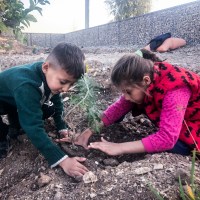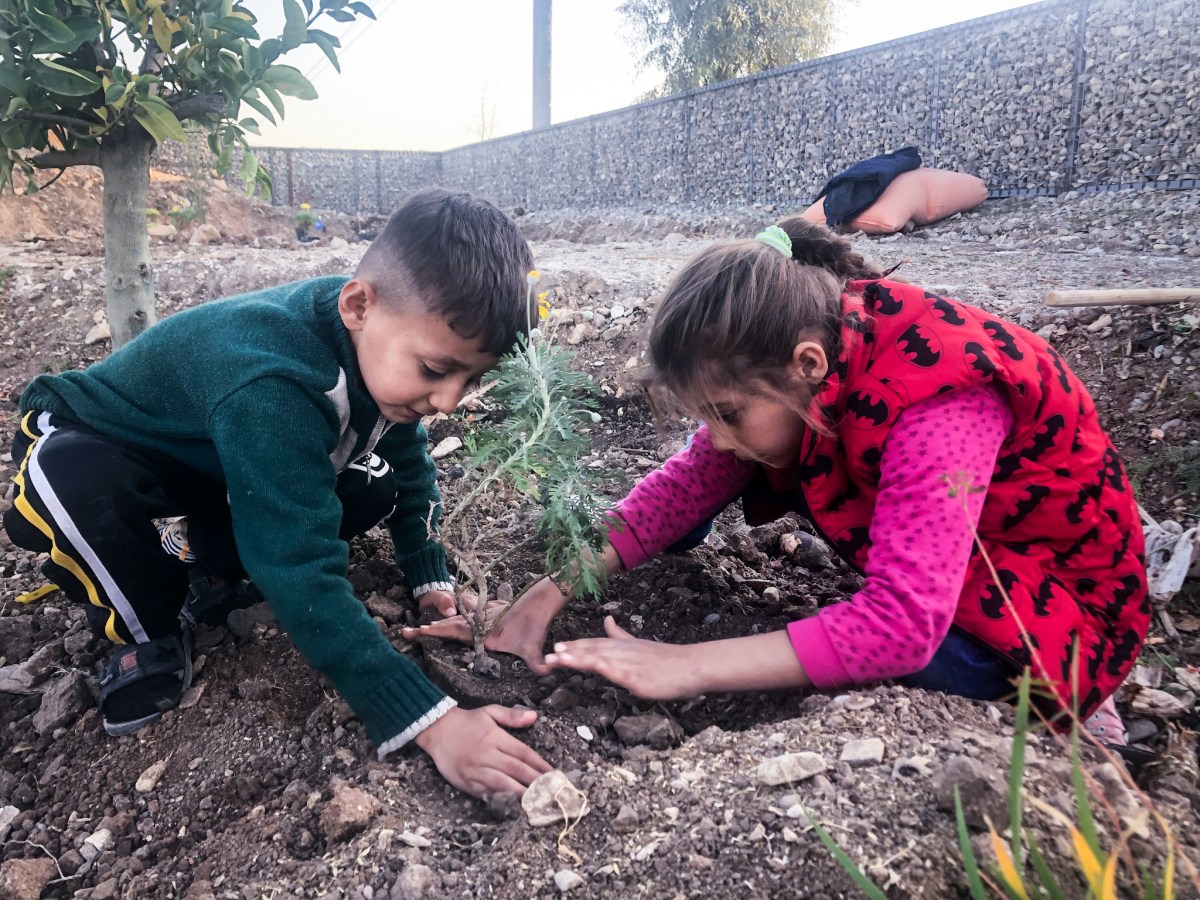We have some big updates from the farm. In a matter of 4 weeks in November, our test farm–located in a refugee camp for Syrians in northern Iraq–transformed from this…
To this—with the help of many hands, including farmers’ Muhiedeen and Aziza’s children (at top) who were so excited to help with planting.
Approaching First Anniversary of Farm Trials
This spring, as we cross the 1-year anniversary of first turning soil in our testbeds, we will literally be digging deeper into our work as further fruit/nut-bearing trees are planted. We will increase the tree varieties in our nursery through grafting and propagation practices with the goal of entering the market for tree sales in 2023. For the first quarter of the year, we will also emphasize fast-growing annual production with the plan to sell starter plants of unique varieties–such as purple tomatoes and husk cherries–for market research. The increase in locally available varieties will help increase sustainability in the region’s agricultural sector and food system.
A Wet, Frigid Winter
At the farm, the water tanks (that store rainwater from our artisan hub roof) are overflowing and our infiltration basins are full. Over a two-week period, we received 4” of rain/snow! That is 26% of the total precipitation for an average year. While it is a much-needed relief from the drought of 2021, there are challenges that come with receiving this much precipitation in a short period of time, such as flash floods, crop loss, and infrastructure damage.
The beauty of the snow is that it will slowly melt from the mountains and release into streams —making water accessible for local farmers throughout the spring and (Inshallah, or “God willing” in English) into the summer, helping mitigate the challenges of the dry summer months.
The winter weather for some weeks was unusual. It reached -15°C/5°F in comparison with the 47°C/115°F we experienced in the summer. The drastic temperature range along with its unpredictability is forcing farmers to either adapt or lose their crops. On the farm, some of our techniques demonstrate how to mitigate extreme weather events. The two thermometers in this image show the temperature of bare soil (3°C/37°F), and then the temperature of the soil in a pit filled with mulch (6°C/43°F). This temperature difference protects the roots of sensitive crops, helping to ensure their survival into the spring.
Investing in Seed Diversity
We are growing a seed bank! Two in every five plant species in the world are at risk of extinction. That is our global storehouse of nutrients, medicinals, system regulators, animal food, and locally adapted varieties that can handle extreme weather conditions.
There are over 50,000 known edible plants in the world, yet only three (rice, wheat, maize) create 60% of the world’s food energy intake, making our food system quite fragile.
Yet, there is hope! Seed savings is seen as the basis for maintaining biodiversity and creating a secure and sovereign food system. This year, through interactive workshops on the farm, our farmers Yaser and Aziza will demonstrate and lead discussions on historical practices for preserving local seeds. In the coming years, the seed bank will create a revenue stream for the farm and increase seed security for the region.
Fluorescent Spring
After a long winter, we have been celebrating the arrival of spring with every blossom on the trees that weathered the week-long frost of January. In February, we closed a polytunnel full of freshly planted seed trays, and in March we opened it up to a blanket of growth. The grounds are covered in bright green cowpea, which will act as ground cover to cool the soil during the summer and as natural fertilizer to encourage the growth of spring.
While much of what fills the farm is intentionally planted, we also enjoy the native forage that speckles the land honoring the foraging history of the Kurds. From our late start last year to our early start this year, we are all enthusiastic to see the harvest and the tables it will fill.
[Throughout the growing season, photo updates from the farm will be posted at Instagram. Follow us there for plant progress and occasional hedgehog sightings.]


